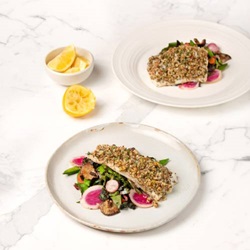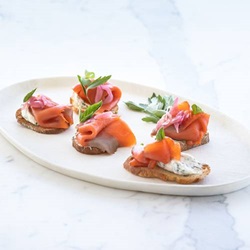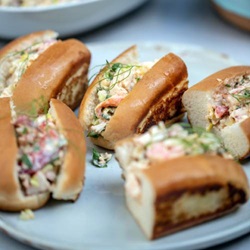6 tips and tricks for incorporating more sustainable seafood into your diet
Does the start of a new decade have you feeling motivated to incorporate more healthy and planet-friendly habits into your life? We’ve got tips that will help you keep your wellness-focused resolutions throughout the year, boost your heart health, and make well-balanced, simple meals a win-win both for you and the environment. It’s seafood that’s good for you and good for the ocean too!
Seafood is a high-protein option that provides important vitamins, essential omega-  3 fatty acids, and nutrients which are beneficial for brain, heart and eye development, as well as overall health and wellness. But don’t take our word for it; the 2015-2020 Dietary Guidelines for Americans recommends the general population eat at least 8 ounces of seafood per week to reap these benefits.
3 fatty acids, and nutrients which are beneficial for brain, heart and eye development, as well as overall health and wellness. But don’t take our word for it; the 2015-2020 Dietary Guidelines for Americans recommends the general population eat at least 8 ounces of seafood per week to reap these benefits.
“Seafood includes vital nutrients needed for health and wellness at all ages, including protein, omega-3s, B vitamins, and minerals like iron and selenium. These nutrients are essential for strong bones, brain development, and a healthy heart and immune system,” explains Valerie Agyeman, Registered Dietitian and Communications Manager at the Seafood Nutrition Partnership (SNP). SNP is a nonprofit dedicated to educating people about the health benefits of fish and encouraging everyone to eat the recommended amount.
US Department of Agriculture studies show the majority of Americans don’t meet the recommended guidelines for fish and shellfish consumption. Now is a great time to start striving to incorporate more seafood into your diet in order to meet those recommendations. Not only will it help you keep those health-focused resolutions, but you’ll also be eating one of the biggest food trends of 2020, an emphasis on sustainability, according to Food and Wine Magazine.
Making sure the seafood you eat isn’t putting undue pressure on the environment is critical. According to the Food and Agriculture Organization of the UN, 33% of global fisheries have been fished beyond sustainable limits. So how do you meet your seafood consumption and health goals without contributing to overfishing? It’s easy – next time you’re at the grocery store, look for the MSC blue fish label on seafood packaging to know the fish was caught sustainably and can be traced back to a sustainable source. The MSC organization’s mission is to end overfishing and make sure the wild-caught seafood you love is around forever, and you can help us by including MSC certified fish as part of your healthy diet.
To help you get started, here are a few tips for incorporating sustainable seafood into your daily routines.
1. Flaky canned/pouched tuna or salmon goes really well in most salads. Bonus: they’re budget friendly. Try adding it the next time you're putting together a light spring salad or a hearty harvest bowl. Here’s some inspiration:
- Couscous tuna salad
- Salmon and quinoa mason jar salad
2. Seafood isn't just for dinner. Smoked salmon on a bagel is a great way to add more protein to your diet. It also makes for a great appetizer if you’re entertaining. Try one of these to get a taste for other forms of salmon:
- Smoked wild salmon crostinis herbed cream cheese and pickled shallots
- Everything spice cured wild salmon bagel crisps cream cheese dill and capers

3. Become a fresh fish expert in two steps. When you’re buying fresh fish from the counter, there are two things to check for to ensure you’re getting the highest quality seafood: the flesh should be firm and it should smell like the ocean. Simple as that! After you’ve purchased it, you can feel confident cooking it at home with this video on how to pan sear or oven roast any filet, no matter what size!
4. Don't be afraid to buy and cook frozen seafood! Here are a few recipes that include instructions on cooking with frozen seafood.
- Nut and herb crusted baked haddock
- Scout's lobster rolls
- Salmon with a maple soy glaze
- Wild pan fried salmon pumpkin puree

5. Get the kids in your life excited about seafood by making it dippable! Or cut it into fun shapes! Our friends at the Seafood Nutrition Partnership have a ton of great tips for getting kids excited about seafood.
6. Make sure it’s certified. This one is easy; just look for the MSC blue fish label on your seafood products. Choosing MSC certified seafood can have a big positive impact by supporting companies who prioritize sustainable options. You can buy seafood that supports livelihoods and fishing communities and ensures seafood is around for the next generation. And, you don’t have to miss out on all those amazing health benefits. There’s no need to compromise – the MSC blue fish allows you to eat fish that’s always wild and as sustainable as it is delicious and nutritious.
